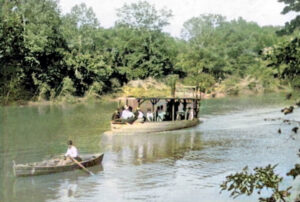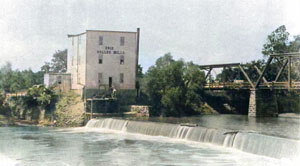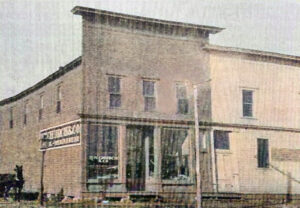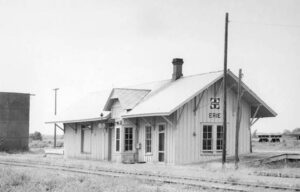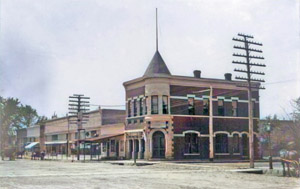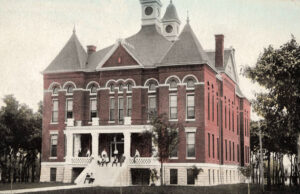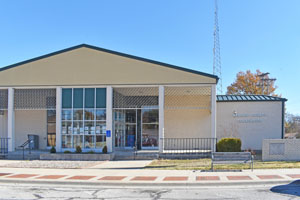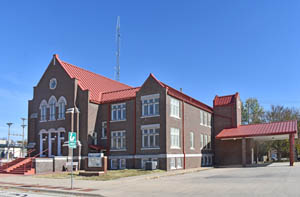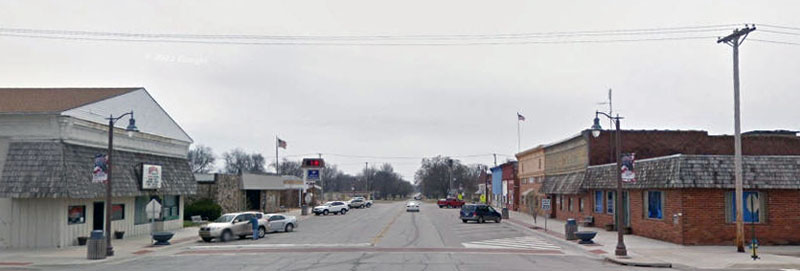
Erie, Kansas Main Street, courtesy of Google Maps.
Erie, Kansas, the county seat of Neosho County, is located three miles east of the county’s geographical center in the Neosho River Valley, surrounded by the beautiful Osage Cuesta Hills. As of the 2020 census, the city had a population of 1,047 and a total area of 1.21 square miles, all of it land.
Erie was founded in 1866 as a compromise between two nearby rival towns — “Old Erie” and Crawfordsville. Erie, later called “Old Erie,” was platted two miles northwest of the present townsite, while Crawfordsville was started two miles northeast of the current site. The proprietors of the two towns made a compromise, agreeing to abandon both places, donate land, and select the present townsite for the new location. It was near a lake for which the town is named.
Before the formation of the Erie Town Company, A.H. Roe and J.I. Denison had established a store about a mile and a half northwest of the Erie townsite. A post office was established there on April 6, 1866, with A.H. Roe as postmaster.
In the summer of 1866, John A. Weston and Miss Roe taught a subscription school in the township. In November that year, the Erie Town Company was established by D.W. Bray, Luther Packet, Peter Walters, and J.F. Hemilwright. Each company member donated 40 acres of land in Section 32, Township 28, Range 20 East. Erie’s first fire company was established that month; its charter members were those men who had donated the land on which the community was built. A dozen others were later admitted to membership.
Mrs. Elizabeth E. Spivey built the first house, a log cabin. The building was later used as a school, church, boarding house, and other purposes.
In 1867, the county offices were at a point called Old Erie, and the first term of the District Court was held at Old Erie in September 1867. The Honorable W. A. Spriggs of Garnett was the presiding Judge. T.C. Cory was appointed by Judge Spriggs County Attorney and acted in that capacity throughout the term. T.J. Brewer was Clerk of the Court, and the lawyers in attendance from Neosho County were J.C. Carpenter, B.P. Ayers, Tom Bridgens, and C.F. Hutchings.
That year, Dr. C.B. Kennedy, Dr. A.F. Neely, and J.C. Carpenter erected the first store in Erie on the corner of Fourth and Main Streets. Virgil Stillwell put up a residence and built the first livery stable. Barnhart Bros. and H.H. Roe located a sawmill a half mile southwest of town. The first term of the District Court was held at Old Erie in September 1867, with the Honorable W.A. Spriggs of Garnett presiding. T.C. Cory was appointed as the County Attorney, and T.J. Brewer was the Clerk of the Court. J.A. Wells built a hotel that opened for business on December 31, 1867.
The first public school teacher was John Broadbent, who, in the winter of 1867-68, taught a school in the little log house built by Elizabeth Spivey.
John Graham built the first blacksmith shop in early 1868, and Carpenter & Porter opened the first law office about the same time. J.W. Stewart & Sons established a flouring and sawmill on the townsite.
Due to insufficient accommodations in Old Erie, the Board of County Commissioners held the spring term of court in the schoolhouse in Erie in 1868. Elections regarding the county seat were held, and factional feelings ran very high. The commissioners declared Erie successful. The county offices were moved to Erie in July. Reverend Isaac Hoagland preached the first Protestant sermon on the Erie townsite.
On October 24, 1868, the Neosho Valley Eagle newspaper started at Jacksonville on May 2, 1868, by B.K. Land was moved to Erie. On March 22, 1869, it was purchased by Kimball & Burton, enlarged from a six to an eight-column folio, and the name was changed to the Dispatch.
That year, J.W. Stewart and his sons built a dam across the Neosho River, removed the equipment from the former flouring and sawmill, moved it one mile south, and started a waterpower grist mill called Erie Roller Mills. It was a one-and-a-half-story building with three runs of buhrs.
The Methodist Episcopal church was organized in the spring of 1869 by Reverend T. Palmer. It had 15 members, and meetings were initially held in the public schoolhouse. Dr. C.F. Stauber organized A Christian Church congregation and became the first pastor, holding meetings at his home. However, services had been held before that time by Elder George Booth and Dr. Jones, occasionally in the log house owned by Mrs. Spivey. Later, services were held in the schoolhouse. A Baptist congregation with seven members was also organized in 1869. Elder A.C. Bateman was the first pastor to hold services in the schoolhouse.
By 1869, Erie had a population of over 800. By that time, many dwellings and several business houses had been erected. Merchants, mechanics, doctors, lawyers, real estate agents, newspapers, and other enterprises had added to the place’s material growth. A schoolhouse sufficient for the district’s needs was erected, and churches were built.
T.T. Gilbert built a business house surpassing anything that might be constructed. This house was the city’s most spacious two-story, double-front business building for many years. At various times, it served as a courthouse, public hall, county offices, fraternal society hall, printing office, hotel, and residence.
Erie was organized by a decree of the Probate Court on December 25, 1869, and trustees were appointed, including J.A. Wells, G.W. Dale, John McCullough, Isaac M. Fletcher, and Douglas Putnam. The trustees met on December 30, and Erie was incorporated as a city of the third class. J.A. Wells was elected mayor, and all the other officers were appointed. Despite the difficulty of obtaining lumber and other building materials, the town had 809 residents then.
After the court proceedings were held, the county seat was moved to Osage Mission (St. Paul) one night in January 1870. The county records being stolen from Erie caused considerable excitement. However, they were never found, and legal proceedings were brought to regain them. At that time, it was evident that Osage Mission had the advantage of a railroad in addition to the county offices, and it began to pull upon the population of Erie.
In 1870, School District No. 5, of which Erie formed a part, bonded itself to $12,000 to build a large stone schoolhouse. During the contest for the county seat, the school district, partaking in the town’s enthusiasm, donated the building to the county for a courthouse and had to pay principal and interest on the bonds. This sum amounted to over $40,000, and the debt was fully extinguished.
J.A. Trenchard became the editor of the Dispatch on December 9, 1870. That year, Erie had 1,200 residents.
On February 24, 1871, J.A. Wells became editor of the newspaper and changed its name to the Erie Ishmaelite. The paper’s publication was suspended on June 2, 1871, and the office material was purchased and removed to the Osage Mission by J. H. Scott and H.T. Perry, who used it to publish the Neosho County Journal.
The Baptist congregation built a new church in 1871 for $1,500.
Many people left the city in 1871-1872, moving to railroad points. The Missouri, Kansas & Texas Railway had been completed through Osage Mission (St. Paul), Parsons was being built up, and the Missouri, Kansas & Texas Railway and Leavenworth, Lawrence & Galveston Railroad. were constructed through Chanute. Those towns were rapidly growing due to the railroads while Erie was declining.
In 1872, most of the business houses in the block from where the Arlington Hotel stood, north of Steinberger’s Drug Store, were destroyed by fire, resulting in a loss of between $10,000 and $15,000, and unfortunately, they were uninsured.
The Christian Church congregation began erecting a church building in 1872. However, because most of its members had moved to other points, its completion was abandoned, and the building was sold to the Methodists.
In July 1873, a tornado swept the county. About 15 houses were blown down in Erie, and 11 people were severely wounded. The combined financial loss of these two events was $20,000. A depression followed, and the town dwindled to 300 residents.
In 1874, those who had stayed in Erie made another fight for the county seat, which proved successful. The offices were moved back to Erie, and the first courthouse was constructed. However, residents found that possessing the county seat did not make a town grow; the exodus continued, and the population declined to only about 300 residents.
The Neosho County Record was established in 1876 by George W. McMillin.
In May 1877, J.W. Stewart sold his interest in the roller mill to A N. Bruner.
In 1880, Erie had two general stores, two blacksmith shops, a drug store, two hotels, a newspaper office, two churches, and a population of about 300. At about that time, A N. Bruner took on a partner, one of the Lodge brothers, who owned a Dry Goods store in Erie, into his roller mill.
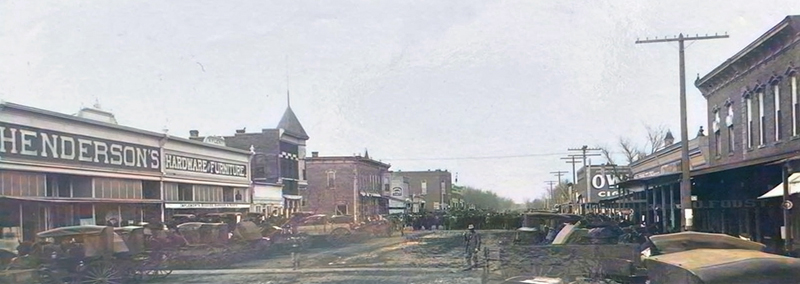
Erie, Kansas Main Street.
In 1882, the Methodist congregation had outgrown its church, and a new and spacious building was erected. Its membership had grown from 15 to several hundred.
In 1883, the Christian Church congregation was revived.
In the spring of 1883, the Atchison, Topeka & Santa Fe Railroad determined that a branch of its road should connect the coal field at Pittsburg with the main line at Earlton or Chanute. That year, a branch from Walnut, Kansas, was built through Erie to Chanute. With this road came new life and new blood. Town lots increased from $1.00 apiece to $100 or more according to location.
Merchants and other businessmen came, bought lots, and built businesses and houses. Brick buildings were erected where the fire of 1872 had burned. These were the Arlington Hotel and several two-story adjoining business houses. Four brick two-story business houses were erected fronting the west of the public square. Then, the main street was curbed and macadamized, and other public improvements were made, adding much to the city’s favorable appearance.
In the next few years, the town began to grow. By March 1884, Erie boasted a bank, two hotels, a nursery, seven doctors, four lawyers, two bakeries, two churches, two grain elevators, two tin shops, a shoe shop, a book store, a brickyard, three coal yards, a newsstand, the courthouse, two billiard halls, a wagon shop, two newspapers, five loan agents, three drug stores, three restaurants, two barber shops, three lumberyards, four livery stables, a millinery store, a gunsmith shop, two clothing stores, a meat market, three dry goods stores, seven grocery stores, two furniture stores, three hardware stores, ten boarding houses, a photograph gallery, four insurance agencies, five real estate agencies, a washing machine factory, several carpenter shops, two public school buildings, and a population of 1,100.
In 1885, a block of brick stores was built on Main Street. The buildings would soon hold the businesses of Miller’s Meat Market, Richey’s Drug Store, the Allen State Bank, and Wright & Dunham-Alderson’s Hardware. The same year, Marion Johnson purchased a part of the Erie Roller Mill. Marion brought his friend R. Kyle into the operation, and together, they operated the mill for several years.
In 1886, Dr. Stauber built a new Christian Church, which soon had a membership of about 300 people.
In 1887, the Missouri, Kansas & Texas Railroad, running north and south, was built through Erie. The township was also induced to extend aid to the Kansas Pacific Railroad, which was built in the city. That year, Barnhart Bros. removed the two-run flouring mill from Erie and moved it to Thayer.
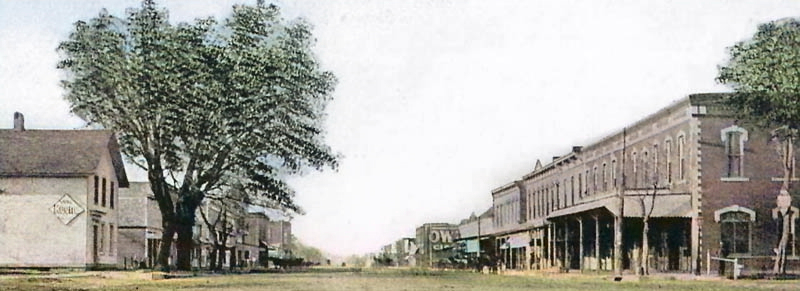
Erie, Kansas, 1896.
In 1899, Wareham & Wood established a long-distance telephone line, and in the same year, the Kansas Telephone Company also installed a long-distance plant. That year, the Erie Roller Mill was moved back away from the river’s bank.
The same year, the Erie Gas and Mineral Company was formed, which drilled and discovered oil and gas. The enterprising citizens subscribed and paid up the capital stock so the company could go to work prospecting for gas. Three wells were sunk on the highland north of the city, one mile. One proved to be a good gas well, one produced petroleum, and the other was a dry hole. Another well was put down in the corporate limits, but while it produced some gas, the flow was insufficient, so it was abandoned. It was then utilized as a mineral well, and its water was claimed to contain excellent medicinal properties.
By this time, the company’s resources had been reduced so much that it had stopped further work. The company had demonstrated that gas was sufficient to supply the wants of the city and its citizens if it were developed.
In 1900, Erie voted $5,000 in bonds to obtain gas for use as fuel and light. It drilled several wells with varying results, but finally, it was deemed best to arrange with the Erie Gas and Mineral Company to take over the work.
An agreement was reached between the city and the company, which resulted in the company’s taking charge of the matter and the city retaining an interest in the plant. The wells developed were being tested and proving satisfactory. The company set to work at once to put in the plant after drilling another well on the Light place about half a mile north of the Mossman Well, where a strong gas flow was developed. Since then, several other wells have been drilled in different directions from the city, nearly every one of which has proven to be a strong gasser. The company had its plant in working order by the time cold weather set in that autumn, and the citizens liberally patronized it, nearly all of whom used gas for fuel and lights.
In the spring of 1901, J.S. Haley installed a telephone exchange. That year, the Bell Telephone Company also installed a long-distance line, with a station at the drug store of Eaton Bros. Soon afterward, J.S. Haley sold it to the Erie Telephone Company, which improved and extended the system, which soon had 108 phones. This system also extended to the town of Shaw.
At the school district meeting held in 1901, it was decided that the district should put down a well on the school grounds. The work was done without delay, resulting in the opening of an excellent well. The gas was piped from it into the school building, which supplied it with heat and lights. The district could not use the whole product then but expected to find a use for it as the population increased and other schoolhouses were built. These developments showed that gas and oil existed not only near the city but also beneath the townsite. Other companies and parties also obtained land leases in the surrounding territory to determine the extent of the gas and oil fields.
That year, the Erie Roller Mill was sold to investors who bought all new equipment. On April 13, 1902, the Erie Roller Mill burned at the same time as a fire in town in Dr. Lake’s pharmacy. The chance that these two fires occurred simultaneously was not coincidental and remained unexplained. The Mill was never rebuilt.
The annual report of the school meeting in June 1902 placed the number of children of school age at 442. Males, 221; females, 221. Enrolled, boys 185, girls 182. Cash on hand was $579.57.
In February 1904, an Opera House opened. It was built with money from people in and around Erie purchasing a membership to the Opera House by “donating” from 5¢ to $50.00 toward the building fund. The lower level of the building, built by Smirl and Baker, held a department store that opened the same day. Innovative for its day, the building had hitching racks for horses and buggies. The upstairs Opera House had a seating capacity of 600 people, beautiful tin ceilings, and a horseshoe-shaped balcony with angled seating so people could easily see the stage lit by 100 gas lights. Admission for the opening play, the comedy-drama The Messenger Boy, was $2.00, $1.50, and $1.00.
The second courthouse built the same year of brick and native stone, had a central cupola surmounted by towers with four round windows each. Dannelly & Halfin constructed it, and George P. Washburn & Son designed it.
Construction on the Great Western Oil Refinery in northeast Erie was almost complete on December 1, 1905. It would be the largest independently owned oil refinery in the world. Before long, the 1,000-barrel plant was running day and night and producing kerosene, gasoline, and 16 byproducts, with the goal of producing at least 5,000 barrels of oil per day. Between 60 and 70 men were employed, and the plant took in oil as quickly as possible.
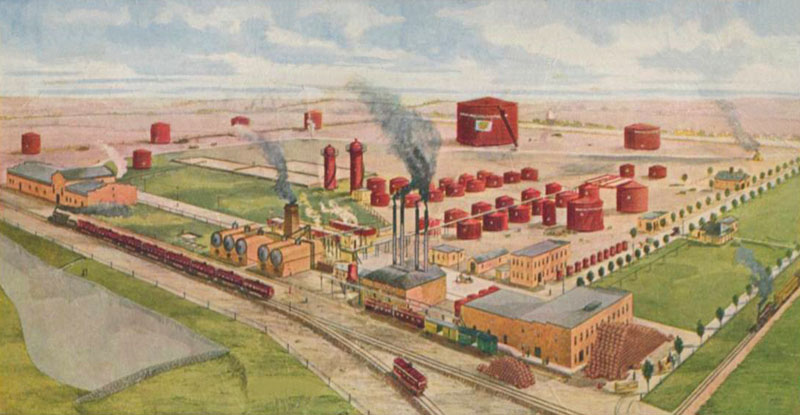
Great Western Oil Refinery in Erie, Kansas, 1905.
In 1906, Erie had two banks, two hardware and furniture dealers; a drug store; several grocery, dry goods, and general stores; an undertaker; four attorneys, four physicians; a dentist, three blacksmiths; a wagon and carriage Maker; a jeweler, two hotels, two newspapers, several livestock breeders, multiple farmers, a Sheriff’s Department, a meat market, two lumber dealers, several men involved in the oil business. Several companies were in operation, including the Erie Petroleum Company, the Independent Torpedo Company, the Kansas City Oil & Gas Company, and the Erie Packing Company.
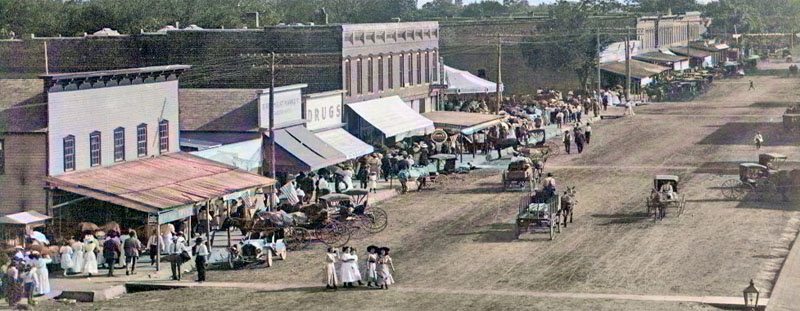
Erie, Kansas Main Street, about 1910.
In 1910, Erie was still on the two railroad lines and was lighted and heated by natural gas found in the area. Its business enterprises included sawmills, flour mills, grain elevators, a creamery, an oil refinery, a canning factory, two banks, two weekly newspapers, and numerous mercantile establishments. It had express and telegraph offices, an international money order post office with five rural routes, and a population of 1,300.
By the early 1920s, the Great Western Refinery had ceased operations because oil production in the area was not sufficient to support its operations. It was located north of the present-day baseball diamond east of town on State Street.
From 1961 to 1963, a new Modern-style Neosho County Courthouse was built in front of the 1904 courthouse. The architect was Kiene & Bradley, and the contractor was Deill Constructing Company. When the new one was completed, the old courthouse was razed. It is located at 100 South Main Street.
Erie’s population fluctuated in the following decades but never grew much. Its population peaked in 1980 at 1,415
On September 18, 2007, the school district passed a $21.9 million bond issue. In the fall of 2010, a new high school opened in Erie, and the old high school was rebuilt into a grade school. A new gymnasium was also built at the Galesburg Middle School.
The old brick Erie Grade and Middle Schools were demolished in the summer of 2013.
Today, the Erie–Galesburg USD 101 public school district serves Erie, Galesburg, Stark, and rural Parsons in Neosho County.
Erie’s tranquil, rural setting is an easy two-hour drive from getaways like Kansas City, Missouri; Tulsa, Oklahoma; Joplin, Springfield; and the Ozarks in Missouri via U.S. Highway 59.
©Kathy Alexander/Legends of Kansas, October 2024.
Also See:
Sources:
Blackmar, Frank W.; Kansas: A Cyclopedia of State History, Vol I; Standard Publishing Company, Chicago, IL 1912.
Cutler, William G; History of Kansas; A. T. Andreas, Chicago, IL, 1883.
Erie, KS
Erie, KS Facebook
History of Neosho and Wilson Counties, Kansas, Published by L. Wallace Duncan, Fort Scott, Kansas, Monitor Printing Co., 1902.
Standard Atlas of Neosho County, Kansas, George A. Ogle & Co., 1906.
Wikipedia – Erie, KS
Wikipedia – Neosho County Courthouse

